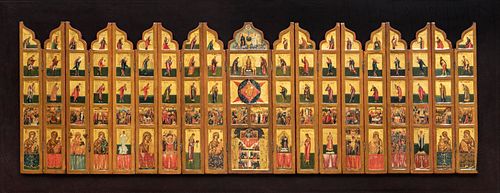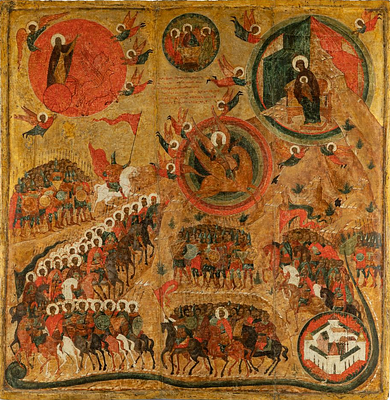Russian School, Old Believers' Workshops, ca.1800. "Portable five-tiered iconostasis". Tempera, gold leaf on panel.
Lot 69
About Seller
Setdart Auction House
Carrer Aragó 346
Barcelona
Spain
Setdart Subastas was born in 2004 and is currently the first online art auction in Spain with solidity, prestige and reliability guaranteed by our more than 60,000 users. Setdart has a young, dynamic and enterprising team ready to successfully manage the purchase and sale of art works through custom...Read more
Estimate:
EUR€10,000 - EUR€12,000
$10,752.69 - $12,903.23
Absentee vs Live bid
Two ways to bid:
- Leave a max absentee bid and the platform will bid on your behalf up to your maximum bid during the live auction.
- Bid live during the auction and your bids will be submitted real-time to the auctioneer.
Bid Increments
| Price | Bid Increment |
|---|---|
| EUR€0 | EUR€10 |
| EUR€200 | EUR€25 |
| EUR€500 | EUR€50 |
| EUR€1,000 | EUR€100 |
| EUR€3,000 | EUR€200 |
| EUR€5,000 | EUR€500 |
| EUR€10,000 | EUR€1,000 |
| EUR€20,000 | EUR€2,000 |
| EUR€50,000 | EUR€5,000 |
About Auction
By Setdart Auction House
Sep 23, 2021
Set Reminder
2021-09-23 10:00:00
2021-09-23 10:00:00
America/New_York
Bidsquare
Bidsquare : RUSSIAN ICONS
https://www.bidsquare.com/auctions/setdart-auction-house/russian-icons-7431
Setdart Auction House sofia@setdart.com
Setdart Auction House sofia@setdart.com
- Lot Description
Russian School, Old Believers' Workshops, ca.1800. "Portable five-tiered iconostasis". Tempera, gold leaf on panel. Measurements: 45 x 133 cm; 66 x 155 (frame). Iconostasis as a religious object is one of the most important phenomena of medieval Russian culture. Iconostases of the 15th-16th century can be divided into four types according to the number of levels, or rows, from two to five levels. They also reached their full development in the 16th century with five rows. Iconostases exist both for public use, in churches, and for domestic use, as in the present lot. In their structure they are practically the same as ecclesiastical iconostases, with slight changes, which are linked above all to the convenience of use. Despite its small size, this lot is thematically and structurally sophisticated. The reading of any iconostasis starts from the bottom upwards. The lower level is called the local level. In the case of the lot of interest, it is imitating the structure of an ecclesiastical iconostasis, as it has a door, called 'sacred', in the centre. It has no functional use, but serves to respect the structure. It is decorated with six miniatures. Reading from below, the four Evangelists can be seen, and in the upper register is the Annunciation, divided into two miniatures on either side of the doors. The central miniature of the Last Supper crowns this composition. On either side of the door are the Odighitria and the Pantocrator. In the more traditional iconostasis, St John the Baptist appears in their place. This detail only adds to the value of the piece, as it adds to its exclusivity, since the iconostasis could be modified according to the commission. It is followed by the archangel Gabriel on the left side, and Saint Lawrence on the right. On the left side of the iconostasis, following the image of the archangel Gabriel, there is an icon with an unusual theme, which is the Cathedral of the Archangel Michael, where he leads the heavenly host with the angels, cherubim and other asexual beings. The symbolism of this image is the protection of Christians from any evil. The presence of eight representations of Odighitria, one of them, the second on the right, is miraculous, and also the presence of the guardian angel, the fifth miniature on the left, is striking. Everything indicates that the purpose of this portable iconostasis was the protection of its owner. The second row, known as the 'festive level', contains twenty miniatures depicting the life and Passions of Christ, as well as some of the more popular passages from the life of the Virgin, from her birth to the time she fell asleep. The third level contains the Deesis. It is the most important level of the whole iconostasis, from which its construction really begins. Deesis is Greek for prayer. In the centre of this level is Jesus Christ, as a Pantocrator, enclosed in the two-coloured mystical mandorla, representing the earthly and heavenly beginning of Christ. On either side of him are the Virgin and Saint John the Baptist. This is followed by miniatures of the Apostles and the Fathers of the Church. The fourth level contains the Old Testament prophets, who hold the sacred scriptures in which each one's prophecy is written. In the central register of this level is the representation of the Mother of God seated on the throne surrounded by St. Peter and St. Paul. The iconostasis culminates in the fifth level, which belongs to the antediluvian Patriarchs. These are the characters of the Old Testament, the ancestors of Christ, including the first mortals, Adam, Eve and Abel. In the central register rests the representation of the New Testament trinity representing the Father God, the Son, sharing the throne, and the Holy Spirit in a spherical mandorla.
- Shipping Info
-
In-house shipping available. Please inquire at admin@setdart.com.
-
- Buyer's Premium



 EUR
EUR CAD
CAD AUD
AUD GBP
GBP MXN
MXN HKD
HKD CNY
CNY MYR
MYR SEK
SEK SGD
SGD CHF
CHF THB
THB

















